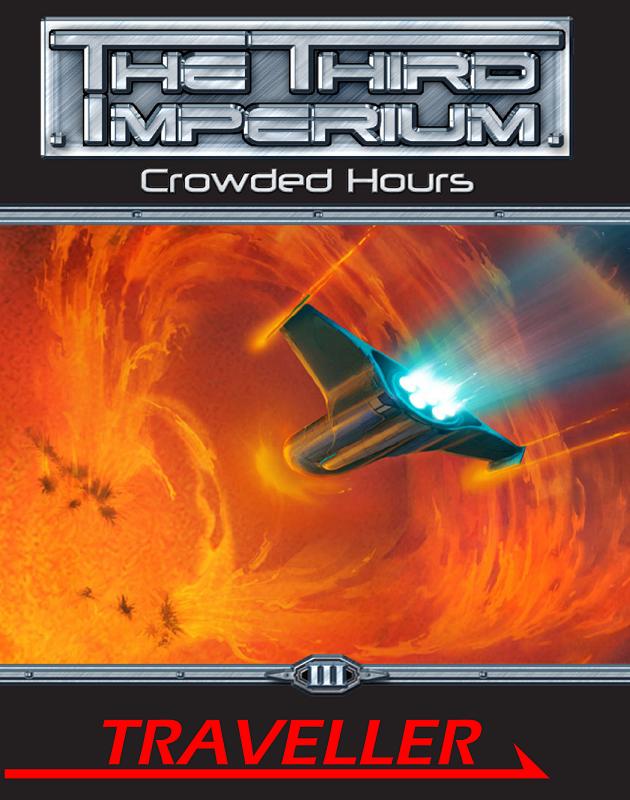This article originally appeared in the March 2011 issue of the downloadable magazine.
 Mongoose
Traveller: The Third Imperium - Crowded Hours. Martin J.
Dougherty
Mongoose
Traveller: The Third Imperium - Crowded Hours. Martin J.
Dougherty
Avenger Enterprises/Mongoose Publishing http://www.mongoosepublishing.com
240pp, hardcover
US$39.99/UKú29.99
This volume is a compilation and re-release of adventures originally released as individual PDFs by Avenger Enterprise through Comstar Games.
On the Shelf
As with other titles for the Third Imperium setting, Crowded Hours places an art panel between the Third Imperium title and book title above, and the Traveller logo below, both on the standard Traveller black background. This volume’s art panel is primarily lurid reds and oranges, showing what might be a merchant ship plunging toward the surface of a star.
Initial Impressions
The four adventures each have a great deal of background information, and are organized to present the background information before the actual adventure material. The adventures themselves are broken up sequentially into scenes, each with plenty of information for the referee. Several of the adventures have appendicial information, such as vehicle plans or character profiles. Artwork is minimal, and limited in quality, though useful.
On Closer Inspection
The author, Martin J. Dougherty, is well-known in the Traveller community for high-quality writing; in addition to these adventures, he is also the author of Mongoose's two previous Third Imperium sector books (Reft Sector and Spinward Marches), Sector Fleet, and Project Steel; he is also the author of Starfarer’s Gazette from Terra/Sol Games, and has indicated that it is not impossible that there will be more Terra/Sol Traveller products over his byline. The adventures in Crowded Hours fully support his reputation for quality writing.
The division into background and adventure material also generally serves as a division into player-character information and referee information; anything from the adventure itself that the player-characters need to know will be fed to them in the course of the adventure by the referee. The ends of the scenes generally mark natural breakpoints, at which the immediate focus of the adventure-in-process changes, and thus for the most part represent good places where the time-limited gaming group can say “Gee, it’s getting late; let’s stop here and pick up next session.”.
In spite of Avenger’s oft-repeated “unofficial” motto, “Roll dice. Blow stuff up.”, there does appear to be plenty of latitude for variation in play style - it’s perfectly possible to achieve most of the goals in these adventures without violence. There is, however, plenty of opportunity to, well, roll dice and blow stuff up, as well, if that’s your preferred style.
Crowded Hours is not without its flaws, however, and these must be laid at the feet of Mongoose’s production staff, rather than at Martin’s, Avenger’s, or Comstar’s. Some of the editing was poorly done—for example, in the first adventure, “Type S”, some of the brief world profiles show the allegiance as “sWORD wORLDS”, a very visible and easily-correctable error. More problematical is the poor quality of some of the artwork—as all of the artwork is clearly meant to be useful, and not just filler, low-resolution scans stretched until they’re grainy or visibly pixellated just won’t do; that there is formerly-informative (but now just unreadable) text in some of those pictures further emphasizes the poor handling of what could have been useful illustrations (the airship plans in “The Windermann Incident” are the most egregious example). This isn’t to say that all of the artwork in the volume is of such poor quality; some of the images were clearly done new (or redone new), and are crisp and readable.
The relative lack of artwork means that someone thumbing through this volume on the shelf will see plenty of dense, grey text, with little to break it up. This makes it physically uninspiring, though taking the time to actually read some of it will reveal that it’s information-dense, not just words-dense. Nevertheless, some additional art to break up the expanses of text would not have been a bad idea, and there are certainly several scenes whose descriptions could have served as inspiration.
Conclusion
Every referee should have some pregenerated adventures on hand for those times when you need something, quickly. These adventures are good choices, well worth the price—don’t let the production flaws drive you away from what is otherwise a top-quality product; you would be hard-pressed to find other adventures as good as these.
 Freelance
Traveller
Freelance
Traveller